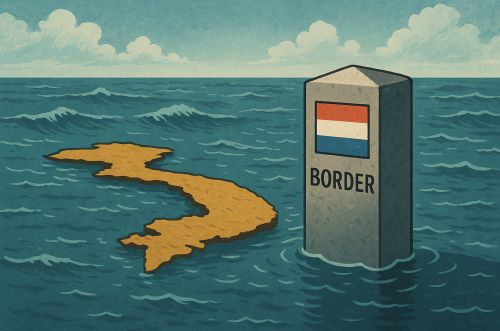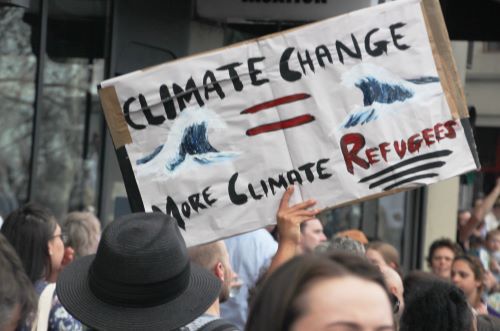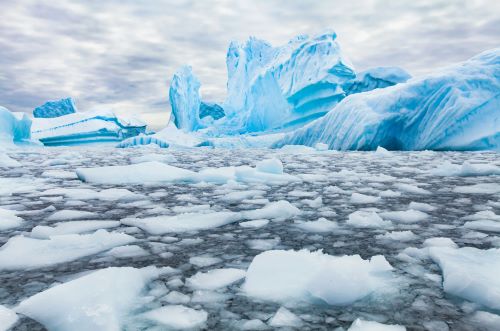

Vanishing edges caused by climate change are not the end. They are the test. Of our systems, our politics, and our humanity.

By Matthew A. McIntosh
Public Historian
Brewminate
Disappearing Islands, Disappearing Nations
In the middle of the Pacific Ocean, the island nation of Tuvalu stands just a few feet above sea level. A sliver of land surrounded by an infinite horizon, it’s home to around 11,000 people, but perhaps not for much longer. Tuvalu is quite literally vanishing. Not metaphorically, not slowly, but tide by tide, storm by storm, inch by inch.
The same story echoes across the Maldives, the Marshall Islands, Kiribati, and parts of Micronesia: homes swallowed by storm surges, ancestral burial grounds eroded into the sea, and freshwater aquifers turned brackish from saltwater intrusion. These are not projections. They are lived realities, made all the more harrowing by the fact that the nations facing existential risk have contributed almost nothing to the greenhouse gas emissions driving the crisis.
The rising sea is more than a geophysical phenomenon. It is a political and philosophical challenge. What is a nation without land? Where do its people go? Who protects their rights? And when the map changes, who decides what counts as sovereignty?
These questions are not being asked fast enough, and in many places, not at all.
The Sinking Legal Order
The international legal framework governing territory and sovereignty was never designed for a world where coastlines move. The 1982 United Nations Convention on the Law of the Sea (UNCLOS) granted countries sovereign rights over a 12-nautical-mile territorial sea and an exclusive economic zone (EEZ) extending 200 nautical miles, measured from the coastline as it existed.
But what if that coastline disappears?
Legally, there is no clear answer. If an island becomes uninhabitable, or entirely submerged, it could theoretically lose its territorial sea and EEZ. That would strip a nation not only of its economic rights to fish and mineral resources, but of its very standing in the international order. And yet, expelling a country from global recognition because of climate change borders on absurdity and cruelty.
Tuvalu and other Pacific nations are calling for “baselines”, fixed points from which maritime zones would remain valid, even if the actual land disappears. It’s a legal innovation rooted in survival. But it remains contested, and the major powers (those who helped cause the problem) have been slow to back such changes.
Without legal reform, vanishing nations risk becoming modern-day stateless entities, exiles without a sovereign anchor.
Climate Refugees in a Stateless World

The term “climate refugee” is deceptively simple, and legally empty. The 1951 Refugee Convention defines refugees as people fleeing “a well-founded fear of persecution” based on race, religion, nationality, or political opinion. It says nothing about hurricanes, floods, or droughts.
That gap is no accident. Countries with the means to absorb large numbers of displaced people, particularly in the Global North, have consistently resisted attempts to expand refugee protections to include environmental displacement. The result is a growing population of people with nowhere to go and no legal right to stay anywhere else.
In 2015, a man from Kiribati sought asylum in New Zealand, claiming he could no longer safely live in his home country due to rising seas and saltwater contamination. His case was ultimately denied, though it sparked global debate. In a later ruling, the United Nations Human Rights Committee stated that governments cannot return people to countries where climate change threatens their lives. But even that ruling was non-binding, a moral gesture more than a legal shield.
As of now, there are no binding international laws to protect those fleeing climate-related collapse. Every relocation effort is ad hoc, every negotiation a tug-of-war between compassion and border control.
Infrastructure Built on a Shrinking Timeline
In wealthier countries, the drama of sea-level rise often plays out in insurance markets and zoning boards. Coastal mansions in Miami are raised on stilts. Seawalls line parts of the Jersey Shore. In the Netherlands, a country that has long lived below sea level, vast systems of dikes and pumps offer a model of adaptation — though one not easily replicable elsewhere.
But in much of the world, infrastructure isn’t keeping pace, or was never robust to begin with.
In Bangladesh, where over 30 million people live in low-lying coastal areas, embankments are failing. Storm surges push further inland each year. In Jakarta, Indonesia, subsidence (land sinking due to groundwater extraction) combines with sea-level rise in a one-two punch that has forced the government to announce the construction of a new capital city on higher ground.
These aren’t engineering problems. They’re political ones. Who gets protection, and who gets relocated? Which coastlines are fortified, and which are surrendered to the sea? The answers depend less on science than on economics, race, and colonial legacies.
When Borders Blur and Power Consolidates

Climate-induced border shifts are not just humanitarian questions. They are geopolitical flashpoints.
Take the Arctic. As polar ice melts, new shipping lanes and resource frontiers open up. Russia, the United States, Canada, and China are all jockeying for influence, laying claims to underwater ridges and ancient rights. In a brutal irony, climate change, which displaces small island nations, is also empowering great powers to redraw maritime boundaries for profit.
The same dynamic is unfolding in the South China Sea. As coral atolls erode and sandbars shift, disputes over territorial control have grown fiercer. Climate degradation is not pacifying global politics. It’s hardening them.
There is a future, not so far off, where the world map will need to be redrawn, not with colonial ambition, but out of climate necessity. Whether that process is done with justice, transparency, and inclusion remains to be seen.
A Reckoning Beyond Rescue
It is tempting to believe that engineering will save us. That nations can simply move, that cities can be rebuilt elsewhere, that identity can float free of geography. But for many cultures, land is not interchangeable. It is history, memory, sacredness. It is not something you can pack up and relocate.
For the Marshallese or the Maldivians, the loss of land is a loss of self. Oral traditions, burial sites, ancestral homes. These are not transferable assets. They are living heritage, and the sea is erasing them.
If the international community cannot recognize and address this crisis, not just as an environmental issue but as a crisis of sovereignty, law, and human rights, then it is complicit in a slow violence that will define the century.
Conclusion: Lines in Water
The sea is coming. That much is certain. It is coming faster than predicted, and with less mercy than hoped. In its wake, it is redrawing the very lines that define our world — borders, laws, nations, lives.
The question now is not whether we will adapt. It’s whether we will allow those with the least to drown, not just in water, but in bureaucracy, indifference, and legal inertia. Vanishing edges are not the end. They are the test. Of our systems, our politics, and our humanity.
Originally published by Brewminate, 07.14.2025, under the terms of a Creative Commons Attribution-NonCommercial-NoDerivatives 4.0 International license.


